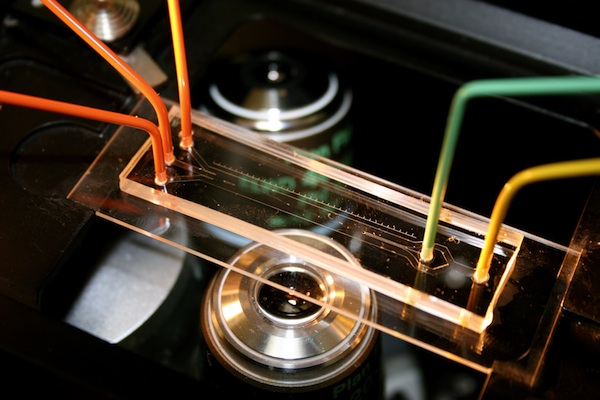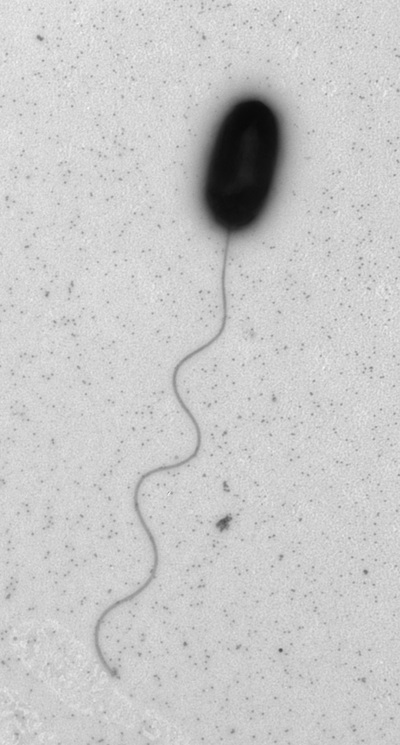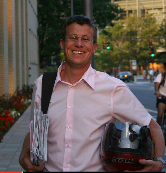Featured Stories, MIT | November 12, 2012
The Hidden Life of Ocean Microbes
By Genevieve Wanucha
MIT’s Environmental Microfluidics Lab in the Department of Civil and Environmental Engineering is equipped to visualize an unseen world. Amongst a web of cables and wires, sit three inverted microscopes and a range of high-resolution, high-speed cameras. Nearby, a microwave beeps. A researcher pulls out a bowl of clear, gooey silicon polymer. He will pour this liquid into molds to make devices capable of holding microcosms of marine bacteria’s ocean environment.
Until recently, ocean scientists have largely considered marine bacteria to be passive floaters and have studied them primarily in static environments, such as Petri dishes, isolated from the turbulent water they call home. Yet, the more this lab group, led by environmental engineer Roman Stocker, learns about how bacteria swim, forage, and sense chemical cues in moving water, the more they are astounded at their sophisticated detection and navigation systems. But that’s only the beginning. At the same time, these MIT researchers are starting to comprehend how life at the microscale can shape the entire ocean ecosystem.

“It’s the same as studying any other complex ecosystem, for example a jungle,” says Stocker. “Ultimately, if you want to understand the ecosystem on the large scale, you have to go down to the level of the single organism: how it finds food, how it competes, how it is affected by its environment. The challenge in our case is that the single organism is invisibly small!”
Stocker achieves this feat by bringing engineering to the table, specifically using the ‘microfluidic’ devices custom-made at the kitchen-like set up in his lab. They are small rectangular slices of clear rubbery material engraved with miniscule channels and mounted on a glass slide. The lab’s researchers can inject bacteria, water, and nutrients into the micro-channels at different locations. Then, using microscopy and high-speed cameras, they record the bacteria as they swim towards the chemicals.
Microbiologist Melissa Garren, a current postdoctoral researcher at MIT, specifically joined Stocker’s lab to apply these microfluidic devices to a bacterial pathogen attacking coral reefs worldwide. This spring, she released the pathogen Vibrio coralliilyticus into a microfluidic device, in which she also placed some mucus collected from coral grown in the lab. As she tracked the behavior of the bacterial pathogen, she observed the creatures vigorously swimming toward the coral mucus. Garren’s experiment revealed that the bacterium hunts coral by “sniffing out” the chemicals exuded at its surface.

Now, Garren wants to probe deeper into the bacteria-coral interaction. “I’m using the microfluidic devices to find what conditions tip the balance between a coral being able to resist an attack versus being susceptible to it,” she says. To do so, she compared the behavior of bacteria in a device containing healthy coral mucus and mucus from a stressed-out coral grown in warmer water, which she and Stocker sampled from Australia’s Great Barrier Reef last summer.
In this experiment, the pathogens zoomed much faster towards the stressed coral than towards the healthy coral mucus. They could actually tell the difference between the two chemical cues. “It was very surprising,” says Garren. “I had no idea this pathogen had so many tricks up its sleeve. These pathogens have quite a lot of control over where they end up—much more than anyone had anticipated.” Her findings hint that increasingly warmer waters around the world could affect coral reef’s susceptibility to infection.
Stocker’s lab is also transforming our understanding of how microbes help remedy anthropogenic impacts on the ocean, specifically by eating up oil after it’s spilled. Researchers often study oil degradation by simply exposing a chunk of oil to bacteria and measuring how much disappears over time. “You get rates of removal,” says Stocker, “but you don’t get an understanding of the mechanisms because you don’t see how bacteria find an individual drop of oil, attach to it, and munch away at it.” By working with microfluidics, Stocker’s group can study the dynamics of bacteria on a single oil droplet.
Recently, they discovered that microbes don’t just swim to oil for a meal, but actively colonize individual oil droplets. The next step will be to assess whether the size of droplets affects the bacteria’s ability to mop up the mess. Perhaps bacteria prefer larger and fewer drops; maybe they more easily attach to smaller, more numerous ones.
Ultimately, this research could inform the engineering of oil dispersants capable of breaking oil into droplets tailored for quick bacterial disposal. “It is this mechanistic understanding at the level of individual organisms and individual interactions,” Stocker adds, “that I believe has the greatest chance of improving our predictive powers of how we affect the oceans and how we might mitigate our impacts.”
Microfluidics transformed more than ocean microbe research. “If it wasn’t for this technology,” says Stocker, “I would never have gone down this path.” Until 2005, he lived in the world of mathematics as an instructor at MIT, using pencils, paper, and textbooks to study fluid mechanics. Pondering his next career move, he began to hear about new devices being developed for the purpose of visualizing chemical reactions at the microscale. He envisioned a use far different. It doesn’t even take a look inside his lab to understand what happened next. Stocker’s old copy of Mathematical Fluid Mechanics is now used to prop up his office computer.







